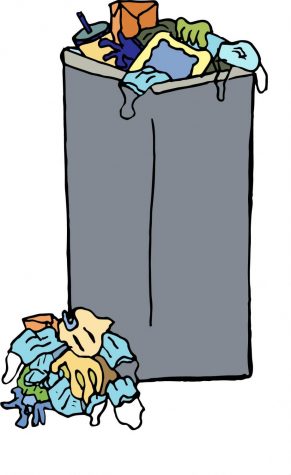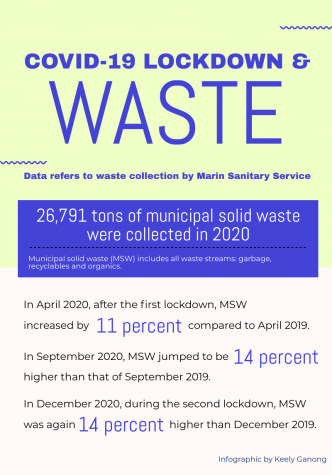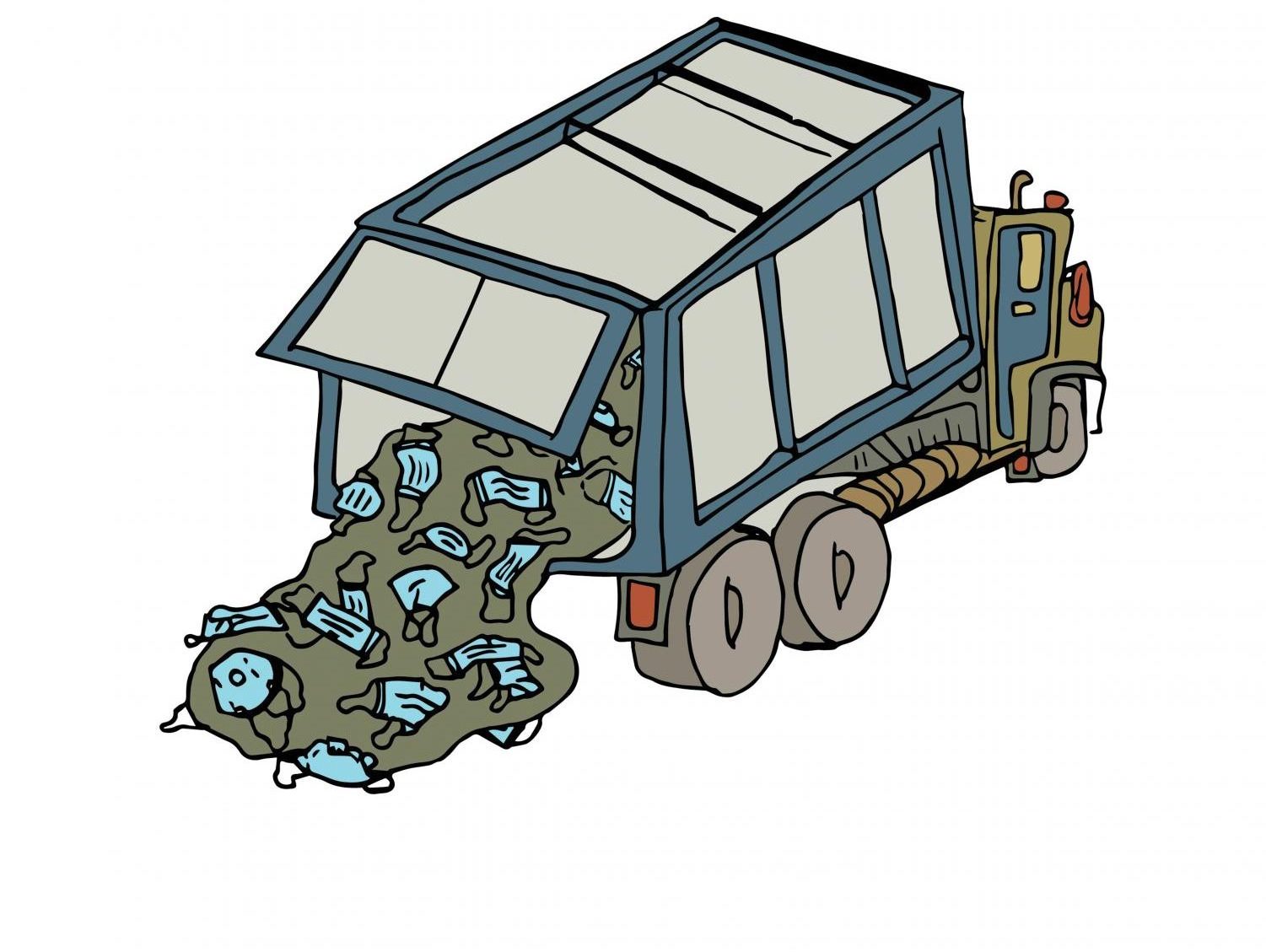How COVID-19 intensified our single-use plastic consumption
February 15, 2021
As people became locked down with fear and uncertainty because of COVID-19, the Earth around us witnessed a silver lining. NASA’s satellite images detected a decrease in pollution levels overtop China after factory doors shut and transportation declined. According to CNN, in New Delhi, the concentration of both fine particulate matter and nitrogen dioxide fell by 71 percent –– this decrease in pollutants released by vehicles and power plants was the result of a nation-wide lockdown of India’s 1.3 billion inhabitants. Venice’s once dark and murky waterways cleared as boat traffic ceased. During the peak of COVID-19 lockdowns in April of 2020, carbon dioxide (CO2) emissions from industry, which account for 22 percent of total CO2 emissions, were down 30 percent. Furthermore, electricity generation, which accounts for 44 percent of total CO2 emissions, decreased by 15 percent globally.

Lockdowns provided our planet with a much-needed break from humans’ detrimental habits. However, with COVID-19 cases on the rise, the hope that lockdowns once projected for our environment failed to consider the increase in single-use plastic consumption.
From the beginning of COVID-19, personal protective equipment (PPE) was in high demand. According to the South China Morning Post, a Hong Kong newspaper, single-use face mask production in China surged to 116 million masks made per day in February 2020, 12 times more than the usual quantity before COVID-19.
When treating a potential COVID-19 patient, health care workers require specific PPE products. Protection includes a single-use disposable plastic gown, a face mask and plastic eye protection (such as an eye shield or full face shield). Because PPE must be replaced frequently with clean sets to limit the risk of cross-contamination, single-use supplies were produced and consumed in unprecedented numbers. The South China Morning Post recorded that hospitals in Wuhan, the origin of the COVID-19 outbreak, manufactured more than 240 tons of single-use plastic-based medical waste per day at the pandemic’s peak between February and March of 2020, six times the average rate before COVID-19.
Marin resident Kalie Dove-Maguire works as an emergency physician and clinical instructor at the University of California San Francisco, California Pacific Medical Center and Kaiser Permanente Medical Center. Dove-Maguire says that hospitals’ increased vigilance towards protection changed the response protocol when treating all patients.
“Pre-pandemic, if you saw somebody with a fever, you wouldn’t go in [wearing] a full garb. But as soon as the pandemic became acknowledged by the U.S., all of that changed,” Dove-Maguire said. “[Now,] when I see a patient with a fever, which could be the flu or any sort of infection, I have to do the whole shebang with all the gear.”
However, the increase in consumption of single-use plastics is not limited to PPE. Online shopping has accelerated dramatically to accommodate all the material needs of people staying within the safety of their own homes. According to Facteus, a financial data firm, consumer spending on Amazon between May and July of 2020 was up 60 percent compared to the same months in 2019.
Ruben Hernandez, Government Affairs and Food to Energy Program outreach coordinator at Marin Sanitary Services (MSS), notes that online orders may offer convenience, but they are increasing our single-use plastic consumption.
“Anything that you order online comes in some kind of packaging. Now that people aren’t going out to do their shopping, they order for delivery,” Hernandez said. “Everything comes wrapped in some kind of packaging that is [often] neither recyclable nor compostable, so it ends up going to the landfill.”

With restrictions on indoor dining in California, many restaurants shifted to accommodate take-out orders for their customers. Though to-go containers were commonly used before the pandemic, they have become the most practical option to serve most of the food that restaurants make, and therefore usage has increased significantly during the pandemic. Food delivery service Uber Eats saw a 152 percent growth in food deliveries in New York in June of 2020 compared to June of 2019. To-go containers that are used in these deliveries are often complicated in their means of disposal. Many are labeled as bioplastics or compostable plastics but are ultimately directed to the garbage since petrochemicals’ presence means that they cannot be recycled or composted.
COVID-19 changed the way that we do just about everything. Adapting to the circumstances that COVID-19 has presented indirectly multiplied our usage of single-use plastics, and our pandemic practices may last.
“Humans are creatures of habit. Once you create the habit of ordering something online and having that convenience to do it all from your own living room, you’re not going to want to go out again to do it like you used to do,” Hernandez said. “I don’t think that the pre-pandemic normalcy will ever return 100 percent, so we’ll just have to adjust.”
The increase in pandemic-related waste has brought staggering growth for garbage. In 2020, the MSS collected 26,791 tons of municipal solid waste (garbage, recycling and composts combined), which is the highest tonnage since 2016.
The MSS noticed a change in residential waste collection as well as garbage trucks’ weight capacity filled up more rapidly per day. Instead of trucks coming to the facility once to complete the route, the collected weight would be so high that they would have to take two, or sometimes even three trips depending on the day. The total amount of municipal solid waste processed by MSS in 2020 increased by two percent compared to 2019. Hernandez assumes that this is because of the increase in single-use items.
Unfortunately, even once the waste is deposited into landfills, our environment is still not spared. Plastics often leak into waterways and scatter in our natural environment. Environmental Science teacher Joe Stewart explains how single-use plastics often harm our environment when they are mismanaged.
“There’s no question that we’re using way more [single-use plastic]. [They are] not even necessarily going in the landfill, but those items are ending up floating around in the ocean. That’s a lot of plastic that gets out into the ecosystem, and that’s more problematic,” Stewart said.
COVID-19 has certainly intensified our plastic consumption, subsequently proving the importance of how we manage our waste. As we continue to navigate this pandemic, we can limit our planet’s destruction by properly disposing of waste and encouraging sustainable actions. Disposable masks can be replaced by reusable ones, plastic utensils can be limited and retail packaging can be better recycled. Even in unprecedented times, consumer consciousness remains important.
